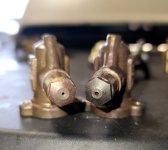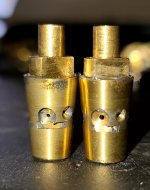Josh Dekubber
TVWBB Gold Member
So I just started taking apart and cleaning natural gas valves that I'm bringing to Arizona to convert my Genesis Junior from LP to NG.
I wanted to know the difference so I'm also taking apart an LP valve to compare. The differences are very minor. As I read in my research natural gas valves and orifices are generally bigger. That is what I'm finding but just barely bigger. I'm going to take apart another NG manifold/valves to compare and make sure. I'll be traveling with these from Washington to Arizona so I want to make sure that I get it right. I haven't cleaned them yet. I just started taking them apart and comparing.
If you have any experience with these please leave me a comment
LP on the left
NG on the right


I wanted to know the difference so I'm also taking apart an LP valve to compare. The differences are very minor. As I read in my research natural gas valves and orifices are generally bigger. That is what I'm finding but just barely bigger. I'm going to take apart another NG manifold/valves to compare and make sure. I'll be traveling with these from Washington to Arizona so I want to make sure that I get it right. I haven't cleaned them yet. I just started taking them apart and comparing.
If you have any experience with these please leave me a comment
LP on the left
NG on the right


